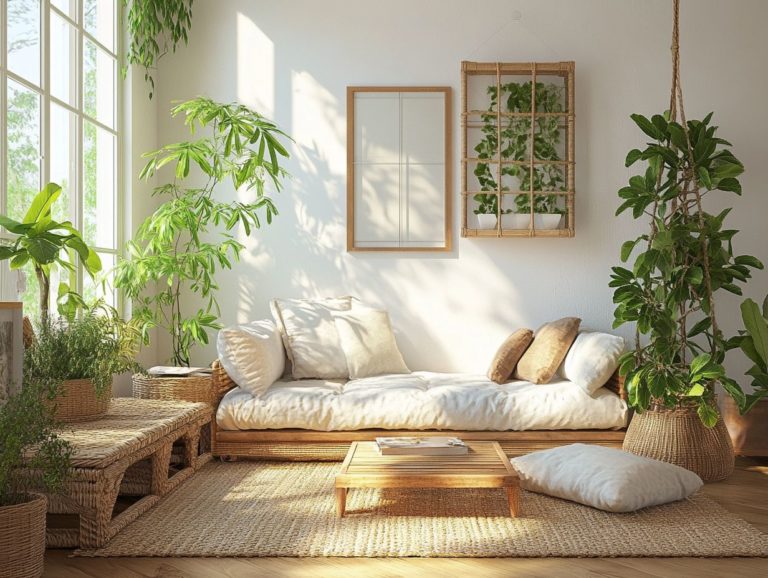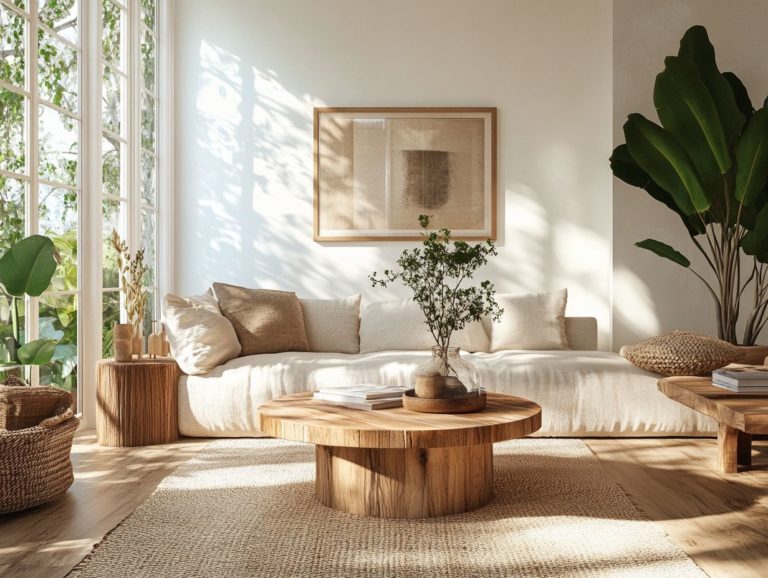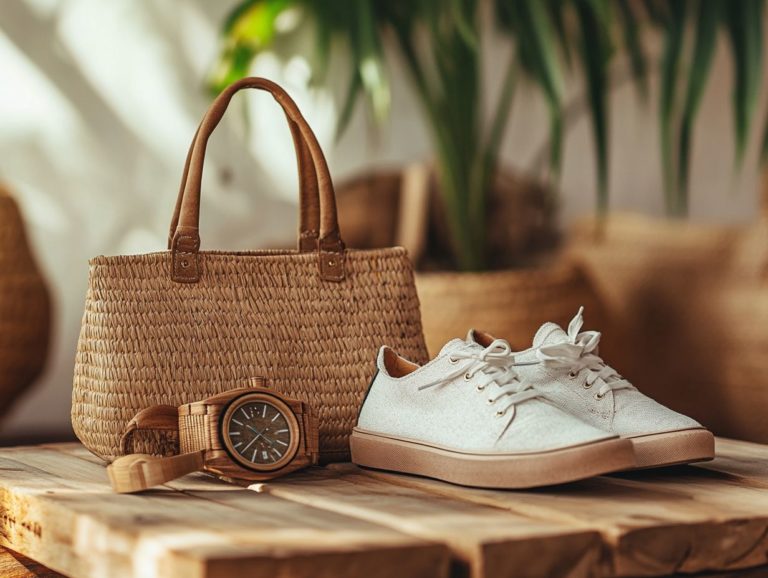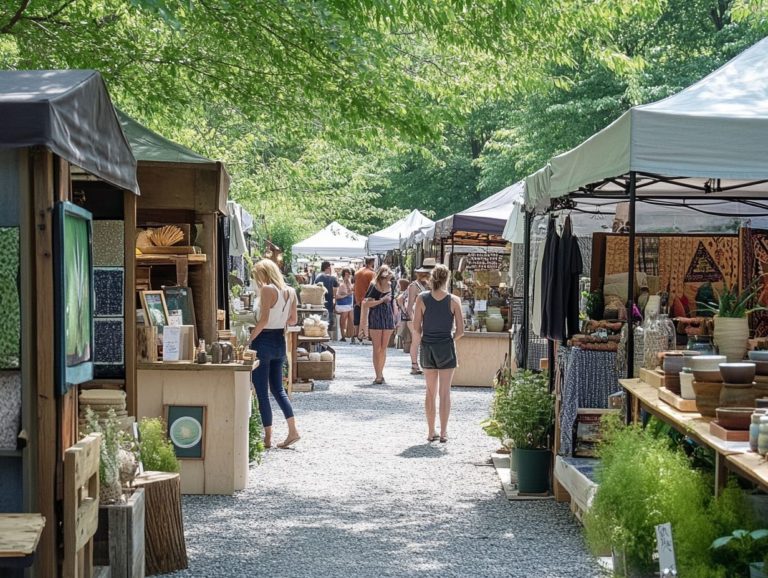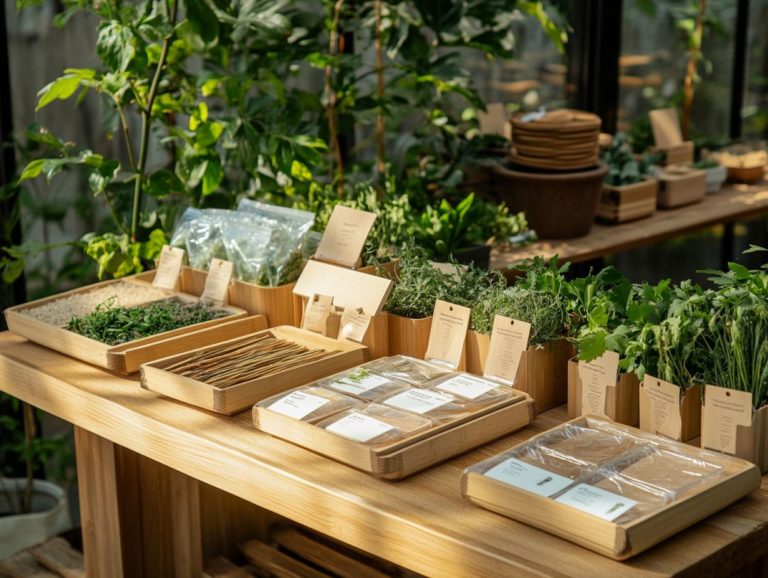5 Unique Uses for Sustainable Materials in Decor
In a world where being eco-friendly has become paramount, incorporating sustainable materials into your home decor enhances aesthetics and demonstrates your commitment to the planet.
Consider the beauty of recycled glass countertops or the charm of upcycled fabric decorations. There are myriad creative options available to make your living space both stylish and environmentally friendly.
Discover unique applications of sustainable materials, learn about their numerous benefits, and get practical tips for sourcing and integrating them into your existing decor.
By embracing a greener lifestyle, you can elevate your home s charm and positively impact the environment.
Contents
- Key Takeaways:
- 1. Recycled Glass Countertops
- 2. Bamboo Flooring
- 3. Cork Wall Tiles
- 4. Salvaged Wood Furniture
- 5. Upcycled Fabric Decorations
- How Can Sustainable Materials Be Used in Home Decor?
- What Are the Benefits of Using Sustainable Materials in Home Decor?
- What Are Some Other Examples of Sustainable Materials in Home Decor?
- How Can One Incorporate Sustainable Materials into Their Existing Decor?
- What Are Some Tips for Sourcing Sustainable Materials for Home Decor?
- What Are the Long-Term Effects of Using Sustainable Materials in Home Decor?
- Frequently Asked Questions
- What are 5 unique uses for sustainable materials in decor?
- Where can I find sustainable materials for my home decor?
- Why should I use sustainable materials in my decor?
- Can sustainable materials be used in all types of decor styles?
- Are sustainable materials more expensive than conventional materials?
- How can I incorporate sustainable materials in my existing decor?
Key Takeaways:
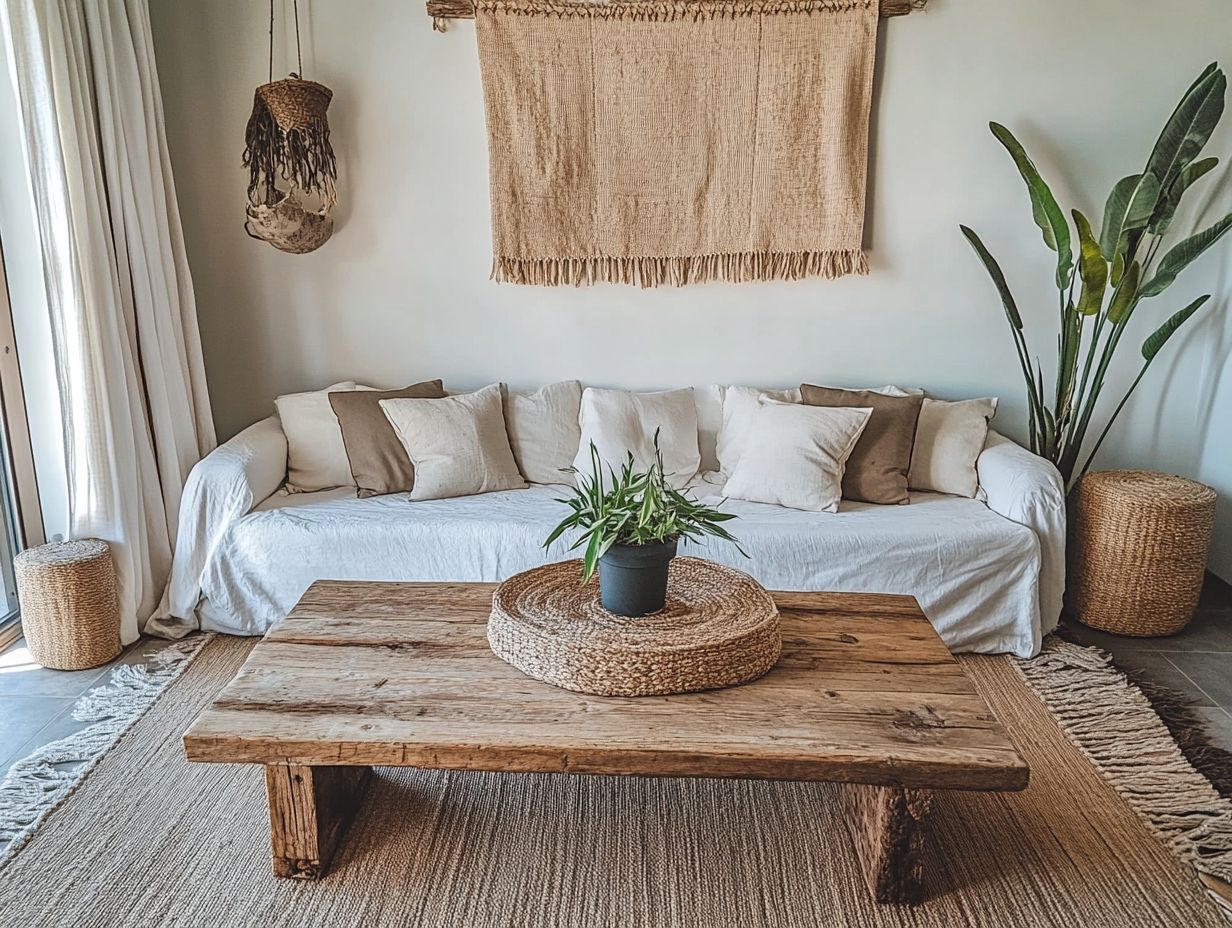
- Using recycled glass countertops adds a unique touch and reduces waste.
- Bamboo flooring is stylish, durable, and a renewable resource.
- Cork wall tiles offer a trendy, eco-friendly alternative with soundproofing benefits.
1. Recycled Glass Countertops
Recycled glass countertops are an innovative and sustainable choice for eco-friendly homeowners eager to enhance their kitchen or bathroom while positively impacting the environment.
These countertops help reduce environmental degradation and promote energy efficiency, meaning they use less energy to produce and maintain.
You ll find stunning aesthetic options, with vibrant colors and unique textures that can complement any design style from sleek modern to charming rustic.
Leading brands like Cosentino and Silestone have perfected the art of blending recycled glass with resin, crafting visually striking surfaces that are impressively durable and resistant to chips and scratches.
Maintaining them is easy; a simple cleaning routine is all it takes to keep them looking pristine.
By embracing recycled glass, you contribute to sustainability initiatives and minimize waste, making this an ideal choice for anyone focused on reducing their carbon footprint.
2. Bamboo Flooring
Bamboo flooring is an exceptional sustainable material that presents an eco-conscious option for homeowners while delivering remarkable durability and visual appeal.
This makes it a favored choice for modern interior design and helps keep energy consumption in check.
Unlike traditional hardwoods that take decades to mature, bamboo reaches full maturity in just three to five years, contributing to forest preservation.
Its natural resilience and strength can compete with and often surpass conventional hardwood floors.
Whether your style leans rustic, contemporary, or minimalist, bamboo seamlessly complements various home decor themes.
Numerous organizations promote eco-friendly building practices, with bamboo highlighted as a prime example of sustainable living.
By opting for this remarkable material, you cultivate inviting spaces that truly reflect your commitment to environmental stewardship.
3. Cork Wall Tiles
Cork wall tiles present a distinctive and eco-friendly option for your interior d cor. They infuse your space with aesthetic warmth and rich texture while enhancing energy efficiency and sound insulation in green homes.
This natural choice boasts exceptional insulation properties, helping to keep your spaces cozy in winter and refreshingly cool in summer, which ultimately reduces your energy consumption.
Pairing cork with non-toxic wall paints creates a safe and healthy indoor environment, free from harmful chemicals.
If you’re considering installing cork tiles, prepare the wall surface properly and use a strong adhesive for lasting results.
Maintaining their beauty and functionality is simple just give them a quick wipe with a damp cloth to ensure they remain a sustainable choice for years to come.
4. Salvaged Wood Furniture
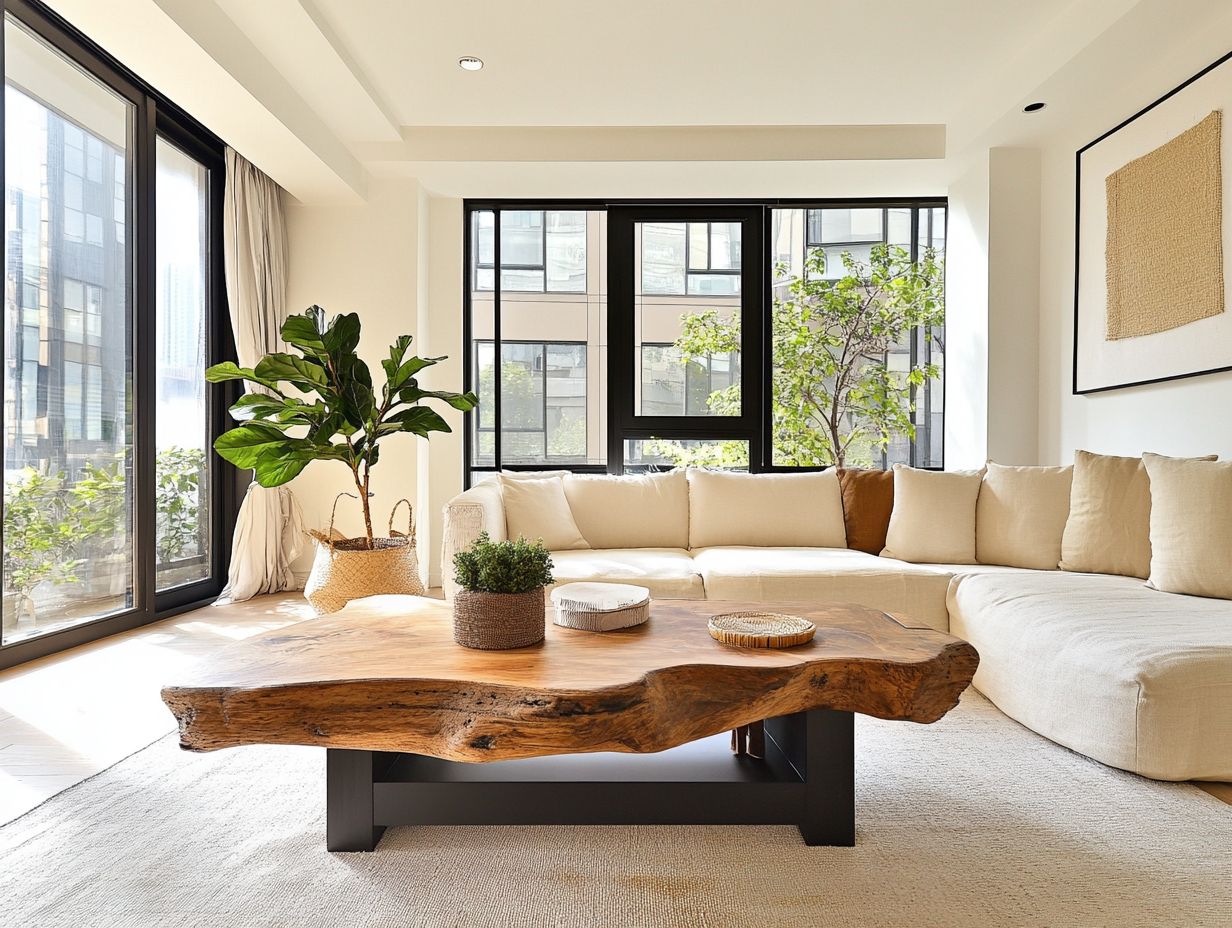
Salvaged wood furniture offers an exceptional opportunity for you to integrate sustainable materials into your home while supporting local businesses. Choosing these pieces reduces your carbon footprint and introduces distinctive character to your decor.
Each piece of salvaged wood possesses its own rich history, weaving a narrative that infuses warmth and individuality into any room. The sourcing process often involves meticulously salvaging materials from old buildings, barn structures, or even discarded pallets. This ensures that nothing goes to waste.
By opting for these unique items, you embrace a greener lifestyle and support local artisans who work hard to transform these remnants into stunning furniture. Choosing sustainable practices adds charm and character to your home while fostering a deeper sense of community connection and responsible shopping.
5. Upcycled Fabric Decorations
Upcycled fabric decorations offer a brilliant opportunity to refresh your home while making eco-friendly choices. By repurposing materials like organic cotton and other textiles, you can create stylish accents that tell a unique story.
Imagine transforming old bed linens into vibrant wall art or crafting chic table runners from discarded clothing. These techniques breathe new life into old items and add character to your space. The beauty of using organic and eco-friendly fabrics lies in their sustainability and enhanced durability.
Incorporating these distinctive pieces into your home effortlessly complements various interior styles, from bohemian chic to modern minimalism. Every corner of your home can radiate a personalized touch while making a positive contribution to the planet s wellness.
How Can Sustainable Materials Be Used in Home Decor?
Sustainable materials are transforming home decor, offering you eco-conscious options that blend functionality with aesthetic appeal. You can make energy-efficient and environmentally friendly choices that create a positive impact.
Incorporating elements such as bamboo flooring, reclaimed wood furniture, and organic fabrics enhances the beauty of your living spaces while supporting a healthier planet. These materials help reduce waste and minimize carbon footprints, encouraging you to reflect on your consumption habits.
Making eco-conscious decisions nurtures a culture of sustainability that yields significant long-term benefits for the environment and future generations. When you prioritize sustainability in your d cor choices, you contribute to a larger movement that values resource conservation and fosters a more harmonious relationship with nature.
What Are the Benefits of Using Sustainable Materials in Home Decor?
Utilizing sustainable materials in your home decor offers a wealth of benefits. These include reducing environmental degradation, lowering carbon footprints, and enhancing indoor air quality. They also encourage an eco-friendly lifestyle.
When you opt for furnishings made from reclaimed wood or non-toxic, organic fabrics, you make a stylish choice and play a part in creating a greener planet. Research shows that homes adorned with sustainable materials can cut indoor pollutants by up to 60%, fostering healthier living spaces.
Using renewable resources often results in unique, aesthetically pleasing designs that echo the beauty of nature. Today, consumers increasingly appreciate sustainability, with 73% willing to invest more in products that positively impact the environment.
This thoughtful approach cultivates eco-friendly habits and promotes a lifestyle that balances beauty with responsibility.
Act now to make a difference in your home decor choices!
What Are Some Other Examples of Sustainable Materials in Home Decor?
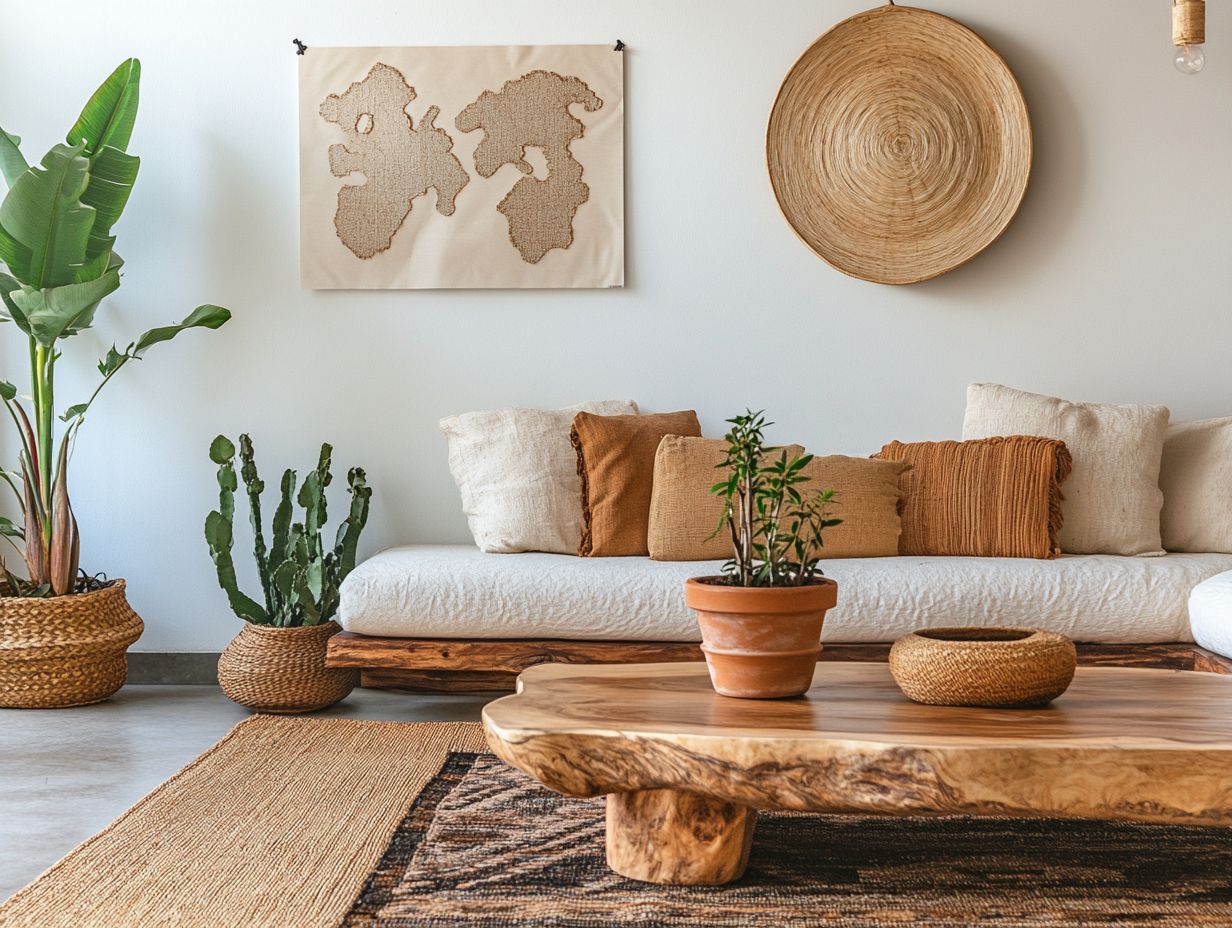
Beyond the familiar choices of bamboo and cork, there are many sustainable materials for home decor that enhance both functionality and style. For instance, bamboo is strong and versatile, while cork is lightweight and easy to maintain. Consider exploring how to incorporate sustainable materials in decor, including organic cotton, recycled materials, and biodegradable options, which break down naturally. These choices not only reduce environmental impact but also elevate the aesthetic charm of your living space.
Take organic cotton, for example. It s perfect for soft furnishings like cushions and throws, providing a cozy, eco-friendly alternative to conventional fabrics. Recycled materials, such as reclaimed wood and glass, can transform into unique statement pieces in your furniture or lighting design, showcasing impeccable craftsmanship while promoting sustainability.
Companies like West Elm and Parachute embrace these trends, offering beautifully designed products crafted from eco-conscious resources. Biodegradable materials, including natural fibers like jute or hemp, add delightful texture and warmth, effortlessly complementing rustic or modern decor themes. Transform your space now!
How Can One Incorporate Sustainable Materials into Their Existing Decor?
Incorporating sustainable materials into your existing decor is entirely achievable with thoughtful design choices. For inspiration, consider exploring the top decorative items for eco-conscious homes. This allows you to enhance your spaces in eco-friendly, energy-efficient ways without a complete overhaul.
Start small by introducing accent pieces crafted from reclaimed wood or bamboo; these additions instantly elevate a room’s aesthetic while making a bold statement about sustainability. For more insights, check out this guide on how to make your home more sustainable with materials. Consider swapping traditional textiles for organic cotton or hemp options. These materials not only exude chic elegance but also contribute to a healthier indoor environment.
Think about furniture made from recycled materials as potential focal points. A striking coffee table or a set of bookshelves can truly transform a space. By combining these elements thoughtfully, you create a harmonious balance between style and sustainability, unlocking limitless potential for inspiration in your home.
What Are Some Tips for Sourcing Sustainable Materials for Home Decor?
Sourcing sustainable materials for your home decor means embracing eco-conscious choices while prioritizing quality and local craftsmanship. This approach supports local businesses and reduces your environmental impact.
Start by exploring local markets to uncover hidden treasures like reclaimed wood, organic fabrics, and handmade pottery, all crafted by talented artisans in your community. Don t overlook online retailers that specialize in sustainable goods; they offer a diverse selection, making it easy for you to find responsibly sourced items that fit your style.
Consider visiting specialty stores focused on green living, where you can discover unique products that resonate with your eco-friendly values. As you navigate these options, conduct thorough research on the materials used and seek out certifications to ensure your choices genuinely reflect sustainability.
Keep an eye out for labels like Fair Trade and FSC-certified, which guarantee a positive impact on both the environment and the community.
What Are the Long-Term Effects of Using Sustainable Materials in Home Decor?
The long-term benefits of using sustainable materials for kid-friendly home decor go far beyond aesthetics; they play a crucial role in reducing environmental degradation, conserving resources, and fostering energy-efficient living spaces.
By prioritizing eco-friendly choices, you’re making a stylish statement while setting a standard for future aesthetics and nurturing a culture that values smart resource management and waste reduction. This thoughtful approach encourages industries to innovate in material production, aligning with emerging trends that highlight functionality and environmental responsibility.
As you become more conscious of your choices, the demand for sustainable options continues to reshape the marketplace. This drives advancements in technology that enhance both the durability and appeal of these materials. Ultimately, this movement promotes overall environmental health, creating a harmonious relationship between your living spaces and the planet.
Frequently Asked Questions
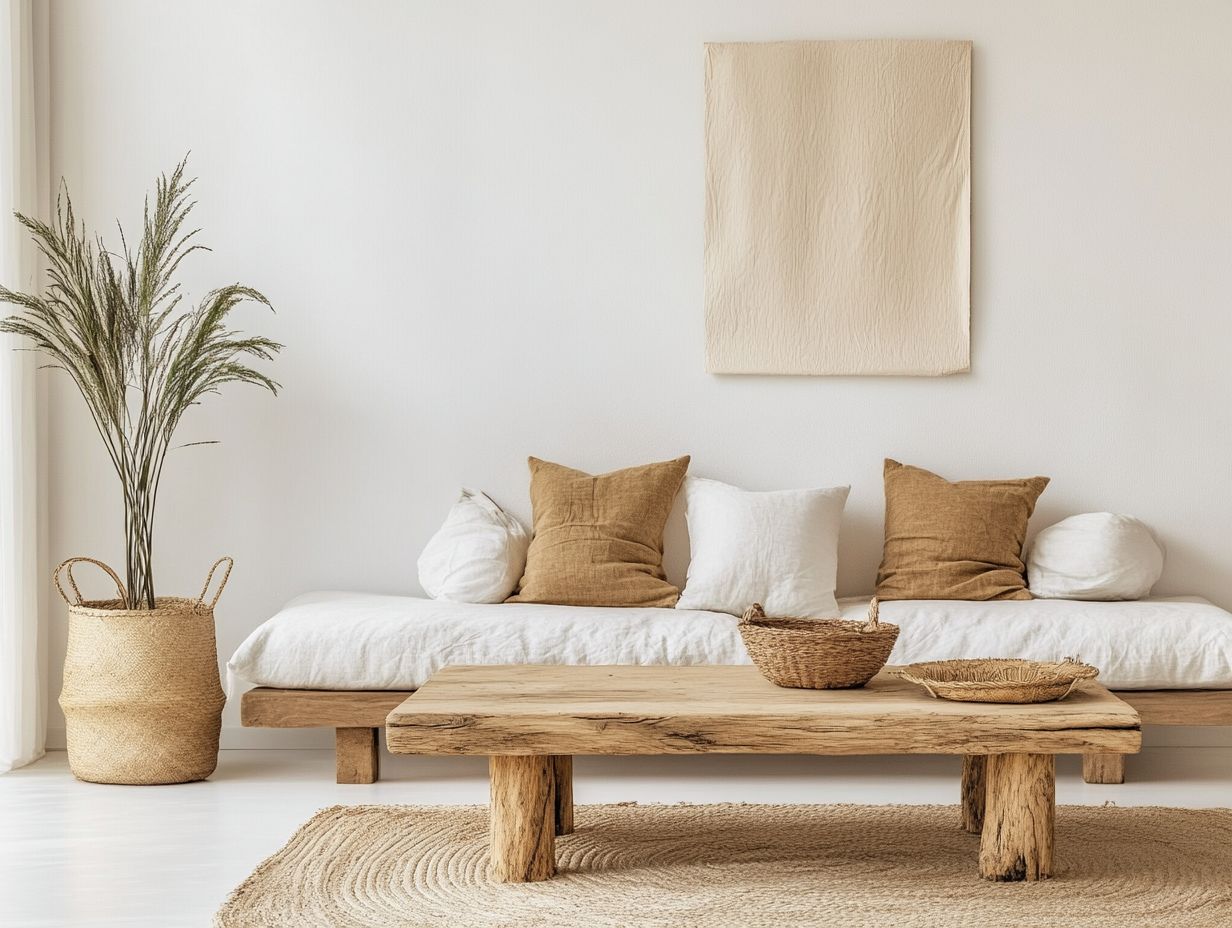
What are 5 unique uses for sustainable materials in decor?
- Wall coverings: Sustainable materials such as bamboo, reclaimed wood, and cork can be used as stylish and eco-friendly wall coverings, adding a natural and warm touch to any room.
- Furniture: Sustainable materials like bamboo, recycled plastic, and reclaimed wood can create durable and stylish furniture pieces, reducing the need for new materials.
- Lighting fixtures: Materials like recycled glass, bamboo, and reclaimed metal can create beautiful lighting fixtures, adding a touch of sustainability to your home decor.
- Textiles: Organic cotton, hemp, and bamboo can make luxurious bedding, towels, and other home textiles, providing eco-friendly comfort and style.
- Accent pieces: Unique accent pieces made from recycled paper, reclaimed wood, and bamboo can add personality to your home decor.
Where can I find sustainable materials for my home decor?
Many online and physical stores specialize in sustainable home decor materials, including The Home Eco, Bambeco, and The Eco Market. You can also find sustainable materials at local thrift stores or flea markets, giving new life to old items.
Why should I use sustainable materials in my decor?
Choosing sustainable materials is a smart move for both your home and the planet. Many conventional materials emit harmful chemicals, while sustainable options use natural and non-toxic ingredients. Using these materials supports ethical and responsible production practices.
Can sustainable materials be used in all types of decor styles?
Yes, sustainable material choices can complement a variety of decor styles, from modern and minimalist to bohemian and eclectic. There are numerous sustainable materials available that fit different design aesthetics.
Are sustainable materials more expensive than conventional materials?
In some cases, sustainable materials may cost more than conventional options. However, the long-term benefits, such as durability and reduced environmental impact, often justify the initial cost. Budget-friendly options like upcycled or thrifted materials are also available.
How can I incorporate sustainable materials in my existing decor?
Incorporate sustainable materials by swapping out traditional items for eco-friendly alternatives. For example, replace plastic or metal picture frames with reclaimed wood or recycled plastic ones. Mixing sustainable materials with conventional ones also creates a unique and eco-friendly look.
Start incorporating sustainable materials today for a healthier home and planet!

